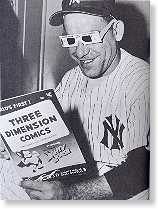 Self-Interest Thrives - The Era of "What's In It For Me?"
Self-Interest Thrives - The Era of "What's In It For Me?"
By David Miranda
A generation ago, brand loyalty was a phenomenon which could be positively exploited by incumbents, i.e. cashing in on good will built over time with constituents. Loyalty (to a product, service, company, leader, media outlet/channel, sports team, significant other, friend, etc.) has been replaced by blatant self-interest. It is a societal trend with a myriad of examples found in all walks of our daily lives. Here are a few:
A generation ago.......
...........people worked for one or two companies in their careers. Today, this is the exception rather than the rule as it is commonplace for people to have many entries on their resumes, i.e. a year here, a couple of years there. Loyalty of a company to its employees or vice versa is, for all intents and purposes, extinct.
...........people loyally consumed the offerings of specific brands over and over - everything from cars, breakfast cereals, shoes, clothing, soft drinks, airlines, telephone service, fast food, etc. Today, in a world of uber-choice and hyper-competition, loyalty is perishable and fleeting.
..........coaches and players were loyal to a specific team, in most instances for the bulk of their careers. Today, free agency and more money has turned both college and professional teams into bands of mercenaries. Coaches and athletes move frequently much to the chagrin of fans.
..........media outlets, such as local newspapers and radio, broadcast news, etc had loyal audiences and readership. Today, with the alternative choices available, audiences are loyal only to their own personal media consumption patterns.
During this shift from loyalty to self-interest, companies have responded with "loyalty" programs (frequent flier or guest programs, credit card reward programs, etc.). Let's face it. These are not "loyalty" programs; these are "self-interest" programs based on greed not loyalty to a specific brand or company. They respond to the points or miles or freebies, not loyalty.
To be fair, there are exceptions.
Apple, Starbucks, Google, Four Seasons Hotels & Resorts, and Nordstrom's, to name a few, have developed a "loyal" following. This enables them to charge a premium for their products and services (or stock). You can, no doubt, add to this list, but the list is short.
It's high time, however, that we call it the way it is - it is about self-interest, i.e. not just "what have you done for me lately?", but rather "what will you do for me now?" Translation: "I have lots of competitive alternatives to spend my time and money. Give me your best deal and I will consider it."
So let's get real. It's not about brand "relationship", "engagement", "loyalty". It's about self-interest. More frankly stated, it is about greed, but as the fictional character, Gordon Gekko stated in the film, Wall Street,
"The point is, ladies and gentlemen, that greed--for lack of a better word is good. Greed is right. Greed works. Greed clarifies, cuts through, and captures the essences of the evolutionary spirit. "
 Employing Marketing's Version Of the "No-Huddle" Offense
Employing Marketing's Version Of the "No-Huddle" Offense
 Busting Common Myths, Mistakes, and Misunderstandings On DIY Marketing
Busting Common Myths, Mistakes, and Misunderstandings On DIY Marketing



 Amateurs Spend Money On Marketing, Professionals Invest Money In Marketing
Amateurs Spend Money On Marketing, Professionals Invest Money In Marketing Your Brand Is Not A Commodity So Don't Act Like One In Media Buying
Your Brand Is Not A Commodity So Don't Act Like One In Media Buying
 Can Your Oldest Living Relative Understand What You're Pitching?
Can Your Oldest Living Relative Understand What You're Pitching?



 Understanding The Difference Is Critical In Marketing
Understanding The Difference Is Critical In Marketing

